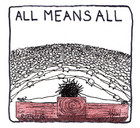David Hayward
(b. 1957)
David Hayward calls himself “The NakedPastor" with a ministry “to bare my soul for everyone to see" and encourage honesty about faith issues. He preaches with pen and paint brush as “a graffiti artist on the walls of religion.” His congregation doesn’t sit in pews in a building on a special day of the week but follows his postings on Facebook, Instagram, Twitter, and other social media. He has even set up a virtual community, The Lasting Supper, which he describes as an on-line safe space for “the spiritually independent.” Quite a turn-around for a former clergyman, once so involved with organized religion, he qualified as “my own ecumenical movement!”
If anyone knows the North American church scene, it is certainly Hayward. Born in Toronto in 1957, he was baptized as an infant into the Anglican Church of Canada. While in his teens, he was “born again” in a Baptist church. Then, he became a Pentecostal and attended an Assemblies of God Bible college, where he met his wife, Lisa. After studying at an American evangelical seminary, Hayward was ordained into the Presbyterian Church of Canada. He was a pastor in a charismatic, evangelical Vineyard community, when he decided in 2010 to quit the ministry and explore faith questions home alone in New Brunswick.
The title of Hayward’s 2015 spiritual autobiography sums up his circuitous spiritual journey: Questions Are the Answer. Moving from church to church, he never found an institutional setting where he could give free reign to his intellectual curiosity and express doubts about traditional dogmas. Hayward compares the experience to changing smaller boxes for bigger ones until one day he realized he could live without the security of four square walls of cardboard. The image of being boxed in appears in the cartoons he started to sketch in 2005, when his time as a churchman was coming to an end.
Hayward always loved to draw and has no formal art training. His style of caricature brings to mind The Far Side sketches of Gary Larson and the probing pen works of John Callahan. He takes us with our shoes on onto holy ground where sacred cows safely graze. In cartoon critiques of the Church’s handling of hot button issues like the role of women and LGBTQ rights the NakedPastor seeks to “challenge the status quo, deconstruct dogma, and offer hope for those who struggle and suffer under it.” Says Hayward: “My cartoons have a way of bypassing rational thought and going straight for the jugular. Once you see them, it’s too late. You can’t un-see them.”
When asked if he is an atheist or a believer, Hayward simply answers “yes.” He considers Christianity to be “my spiritual home—in my DNA.” To get the “punchline” of many cartoons, you need some knowledge of the Bible. The lament of the pig in a sketch showing animals at the manger, boasting of their service to Christ, recalls the Gospel story where Jesus casts demons from an exorcised man into swine that drown in the sea. The unsettling image of a shriveled figure in a cage in Heaven in another drawing plays off Christ’s teaching in the Last Judgment story in Matthew 25:31-46 that what you do for others in this life, you also do to him.
The NakedPastor views current events through a biblical lens. The Holy Family fleeing to Egypt stands in for all refugees and illegal aliens kept in holding pens in one mixed media painting of Joseph, Mary, and the Baby Jesus behind barbed wire. Another image shows the Holy Family (with their iconic donkey, this time) caught in a dragnet at a border crossing, surrendering to police in the cars encircling them. Hayward even takes aim at pandemic era protests against face masks, elevating the dispute to the level of Christian ethics in a cartoon of Jesus wearing a face covering with the words, “Love thy neighbor.”
Hayward often depicts Christ as the leading opponent of the very institutions that act in his name. He is the defender of those targeted and excluded by organized religion. In one cartoon, the Baby Jesus in the manger is troubled by nightmares of what damage will be done by future followers with agendas. An image of Christ restoring the lost sheep to its flock reveals the 99 left in the fold in the New Testament parable had kicked it out. In another sketch, Jesus cadges money on a street corner in hope of buying his Church back from the powerful interests that control it.
A mixed media painting of The Spare Change Christ in the Collection is one of many Hayward images where Jesus becomes the representative face of a broad spectrum of marginalized people and social causes. In a composite poster of NakedPastor Christ portraits, you will find, among 16 variations, an Anti-Nuke Christ, a Refugee Christ, a Feminist Christ, and a rainbow wedding cake-eating LGBTQ Christ. Halos are formed from a Native American dream-catcher, a tortilla, a practice target, a rolled sleeping bag, and even a pizza! The repeated use of the iconographic motif of the Crown of Thorns gives unity to the diversity of the portraiture.
The NakedPastor uses Christian metaphors because he knows them well, but he sees his faith perspective as one of many ways to comprehend the mystery of what he terms, "That-Which-We-Call-God." As Hayward likes to put it, “My home is in Christianity, but I have cottages everywhere.” In one cartoon spoofing the social media “selfie” obsession, Christ takes a photo of himself, which proves to be a snapshot of all humanity. In another sketch, Christ looks down from the Cross on a chain of hand-holding people encompassing the planet. In Hayward’s view, however you may understand the Crucifixion, when the Bible says “Christ died for all” (Corinthians 5:15), then, ALL MEANS ALL. No ifs, ands, or buts.
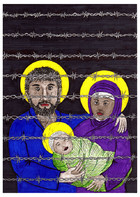
The Holy Family
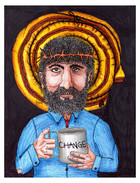
The Spare Change Christ
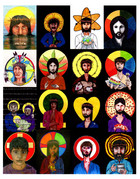
Collection of Christ Images
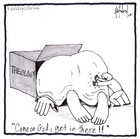
Untitled (Putting God in a Box)
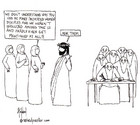
Untitled (Women Disciples)
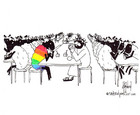
Untitled (The Friend of Outcasts)
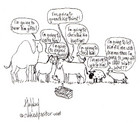
Untitled (Menagerie with a Mission)
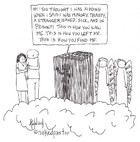
Untitled (How You Left Me)
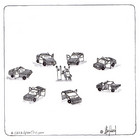
Untitled (Caught at the Border)
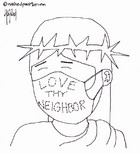
Love Thy Neighbor
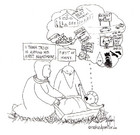
Untitled (The First Nightmare)
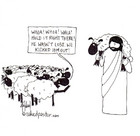
Untitled (We Kicked Him Out)
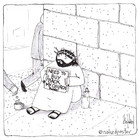
Untitled (Buying Back My Church)
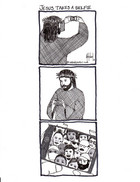
Untitled (The Body of Christ)
